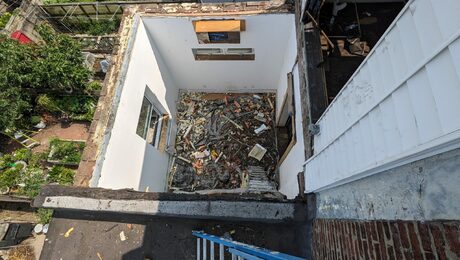I’ve been changing switches out on a house getting ready for rent, and in doing so, have found myself in a bit of a pickle:
By the front door, there are two three-way switches one of which controls the first floor hall light and the other the second floor hall light. Accordingly, there are two three-way switches on the second floor.
The 1st floor box receives power through a 2-wire NM cable, and there are two 2-wire BX cables leaving the box. The 1st floor light box has two 2-wire BX in it: one conductor continues through the box, the other is for connecting the light. The 2nd floor box only has one 2-wire BX.
Now, how, exactly, does one set this up to control each light separately? It seems impossible to me as I stare at it, but it *was* working before I decided to touch it… Other useful clues might be :
– I’ve checked all connections & wirenuts more than twice, but when I try to power on the circuit, it trips immediately
– Before I checked the wirenuts for the second time, the 2nd floor light did work (but not the 1st floor light). The non-contact voltage tester read ‘hot’ on both wires of the test light, but it would not illuminate. (Yes, the light does work).
– The original installation had a wire connecting one traveler on one switch to the same traveler on the other switch in the box on the first floor. The wire was then connected to one of the wires from one of the 2-wire BX cable.
Thanks in advance.




















Replies
Draw it out in schematic form. Otherwise you'll drive yourself crazy.
BTW, why did you mess with it??
Like Dan says, draw it out.
It sounds like you've eliminated a few possibilities given that the power arrives in the first switch box. The two BX runs might be a substitute for the normal 3 wire cable between the switches and load.
Here's a bunch of diagrams that may help:
http://www.homeimprovementweb.com/information/how-to/three-way-switch.htm
You may need to ring out the wires with a multi meter.
(This is also know as the Carter System from the knob & tube era. It's been prohibited by the NEC since 1923...)
So (and I'm not making this up...) :
The power comes into the box via a romex NM 2-wire cable (H - hot, N - neutral).
The switches are wired as follows in the 1st floor box : one traveler is wired to H, the other to N (this is for both switches). Using one of the BX cables (call it BX-1 and the conductors 1 and 2), 1 is wired to the common terminal on the switch controlling the 1st floor light and 2 to the common terminal controlling the 2nd floor light. The other BX cable, BX-2, is wired to H and N (to carry power & the 'travellers').
BX-1 goes to the 1st floor fixture, where 2 continues through the box-- connected to another run of BX, BX-3, containing the cables B and W: the connection here is 2-W -- but 1 is connected to the fixture. The fixture is then connected to B (in BX-3). (Note : No distinction can be made between hot and neutral cables here).
On the second floor, H and N are again connected to the travellers on each switch via BX-2. B (from BX-3) is connected to the common terminal on the switch controlling the 1st floor fixture, and W is connected to yet another run of BX, BX-4 -- with conductors 3 and 4 -- which continues (via 3) through the box to the fixture on the 2nd floor. 4, then, connects to the common terminal on the switch controlling the fixture on the second floor. The final BX, BX-5, simply connects to H and N to carry power to the other fixtures on the circuit.
Finally, the fixture on the second floor is wired to 3 and 4, with no regard to which one is hot and which is neutral.
Why does this work?
Since the hot and neutral are on traveller terminals, there is no way for them to cross, ie they will not short. Cables 1 and 2 are thus either hot or neutral, depending on the position of the switches(with respect to 2, this also implies that W and 3 share this 'state').
Taking a look at the switches for the 1st floor fixture, if 1 is neutral and B is as well, then the fixture is 'off.' However, should B be hot, then the fixture will 'have power.' (The same, of course, is true for the inverse). The same reasoning can be used to explain the behavior of the 2nd switch pair and fixture.
It is important to note that each switched conductor (ie 1, 2, B, W, 3, 4) can be either hot or neutral, depending on the position of the switches. Also, it is not possible to use dimmers on these circuits.
Yeah, this is the old K&T
Yeah, this is the old K&T style 3-way -- now illegal, but still grandfathered, I suppose. It violates the now-rigid rule about never switching the neutral, and also violates the rule about connecting the shell side of fixtures to neutral.
I ran into a case once where this setup was used in a house that had been converted from 120V to 240V with the installation of a new panel. Led to the curious situation where having switches in position AB or BA turned the light on, AA turned the light off, and BB caused the light to go poof.
Good to know, I'll let the 'boss' know. In any case, I wasn't the one who wired it up, it was an old-timer. At least now I'll know for the future.
Thanks again.